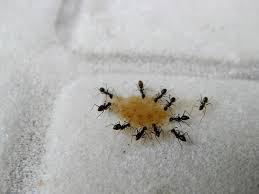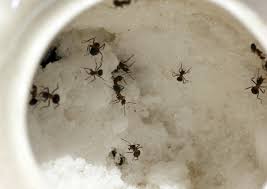Why tiny ants have invaded your house, and
what to do about it
What are ants doing in my house?
Ants are part of nature’s cleaning crew:
they efficiently find and remove food left around the house. The problem is,
sometimes humans don’t want their help. You’ve probably noticed ants more
commonly come indoors in summer – that’s largely because most insects are more
active in the warmer months.
Masters of cooperation
Ants are social animals and live in
colonies with hundreds, or even millions, of others. They have tiny brains – in
many cases smaller than a grain of sand. So how are they so clever at getting
into our homes and finding our food? Because they are masters of cooperation.
How do I get rid of ants?
The first step to dealing with ants in your
house is ensuring they don’t have access to food. Seal all food in airtight
containers, clean behind the fridge and in the toaster, do not leave pet food
out longer than necessary, ensure your bins are tightly sealed, and generally
make sure there is no food around to entice ants (I know, easier said than
done).

Facts About Ants
- There are more than 12,000 species of
ants around the world. The vast majority of these are relatively harmless to
people, although you wouldn’t want to share your dinner with them.
- Ants can carry bacteria, making them
potential transmitters of disease or infection. For example, Monomorium ants
have been foundTrusted Source to carry pathogenic bacteria, which can be
dangerous to people.
- One common house ant, the pharaoh ant,
has been foundTrusted Source to be a potential cause of bronchial asthma and
respiratory allergies.
- Red ants, which are native to certain
parts of Africa, have invaded areas of the Southern United States and
California. These ants bite and are capable of swarming and killing small
animals, such as chickens.

Where Ant Colonies Hide in Your House
If you choose to use insecticides for ant
control instead, focus on cracks, holes and gaps as close to the nest as
possible. Here are some of the odd spots ants where you might find ant nests,
and how to identify the ant colonies and control them.
In foundation walls
Several
types of ants may build nests in or around foundation walls. The most common
are known as larger yellow ants, which rarely cause damage or eat human food.
Pyrethrins and other spray insecticides are effective for getting rid of most
foundation infestations.
Under the concrete slab
If small ants are eating your meat, pet food,
nuts and dead insects, you may be able to trace them to flooring cracks. If so,
they may be living under the concrete slab.
University of Minnesota Cooperative Extension experts recommend baiting
for ant colonies under concrete slabs.
Inside walls
Various ants live in wall cavities and under
floorboards. Many ant colonies can be controlled with syrupy baits.
On insulation
Carpenter ants are among the ants that live in
wall cavities, chewing lumber into sawdust and using the sawdust to help build
their nests. However, they are also foam “carpenters,” chewing up and
reusing foam insulation. They can degrade both wood and insulation over time,
so the University of Minnesota experts recommend finding carpenter ant nests
and spraying insecticides directly into the nests.
In rotted window frames
Rotted wood in window frames and similar spots
provides an ideal home for acrobat ants and other ant species. If infestations
are discovered in wood cavities, inject with powdered insecticides. It’s also
important to replace any rotted wood and get rid of the sources of rot and
moisture.
Behind kitchen cabinets
Tiny grease ants may seem to appear out of
nowhere and sneak into food containers. Rather, they are appearing out of tiny
gaps and cavities in the kitchen, including spaces behind kitchen cabinets.
Such nests can be difficult to find, but baits may work. Also, wipe up all
greasy stains and try to eliminate or seal all attractive food sources,
including oils, meats and cheeses.

4 Signs You Have An Ant Infestation in Your
Home
Therefore, although an ant infestation isn’t
dangerous, it’s certainly a major nuisance. And once an ant problem has reached
infestation level, it’s going to take a lot of hard work to eradicate them all.
If you’re worried you have an ant infestation, here are four signs that could
confirm your suspicion:
1. Ants have overrun exposed food
If you haven’t had pest problems before, you
probably tend to leave leftovers exposed for short periods of time, or keep
items in your pantry in their original containers. When an ant infestation is
present, none of these items are safe. Ants will eventually sniff out the
exposed food, and you will find it crawling with worker ants before long. To
prevent further problems, store all food in the refrigerator or in airtight
containers
2. Fido’s food bowl has been infiltrated
Ants aren’t picky; they’ll eat whatever food
is available, including food which belongs to your pets. If you have dogs or
cats, you’ll likely find a trail of ants leading up to and inside their food
bowl.
3. You notice stray ants walking around
The search for food is a continuous one for
ants, and when there’s a major infestation present, there will be plenty of
scout ants wandering around your home. If you regularly spot individual ants in
unconventional places, such as your bedroom or the bathroom, they are probably
part of a much larger infestation.
4. You find ant nests outside the home
Ants won’t often build their nests inside of
your home, but infestations are usually accompanied by nests that are within
close distance of the house, or even adjacent to exterior walls. Look for small
mounds of dirt with plenty of ants milling around. They will seem minor and
insignificant, but there are countless ants just underneath the surface.
Prevention
Prevention is always the best form of pest
control. Follow these simple guidelines to keep carpenter ants out of your
home.
- /Keep your home clean—particularly the kitchen, flooring, windowsills and countertops. Without a food source, ants will have no reason to enter your home.
- Seal all food in tightly closed containers. Keep all food storage areas free of crumbs and residues (Tip: wipe off all those jam, sauce and honey containers).
- Never leave food remains or dirty dishes in the sink.
- Take the trash out regularly, and keep all trash cans clean and sealed.
- Any spilled food should be cleaned up immediately.
- Seal any cracks, crevices and holes—all potential ant entrances—with caulk or other sealant.
- Remove or remedy all sources of unnecessary moisture both inside and outside your home, including: leaky plumbing, basements, crawl spaces, A/C units, hoses, faucets, sprinklers, clogged drainage areas, etc
- Remove possible nesting spaces from your yard, such as: woodpiles, wooden yard equipment, brush, dead or dying trees & tree strumps, unused dog houses, furniture, and any other possibly moist, wooden items.
- Keep tree limbs and branches away from the walls of your home. Carpenter ants use these as bridges to enter your home.
- Do not store lumber or firewood inside or right outside your home.